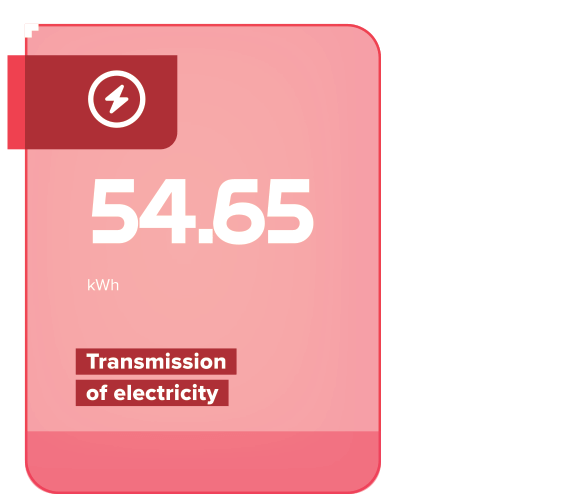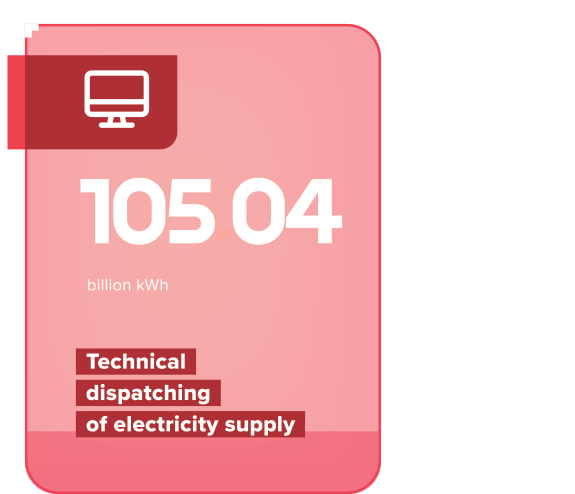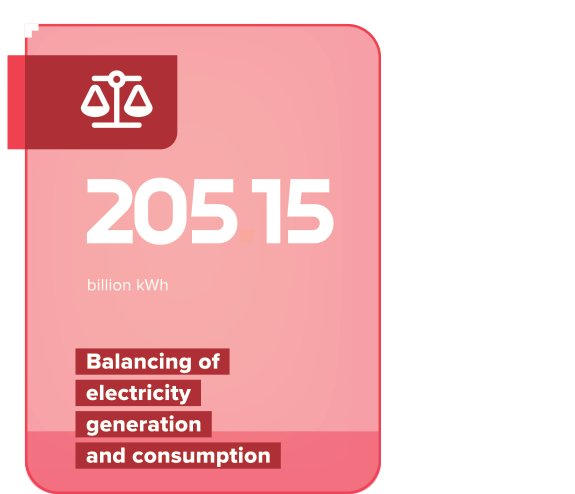Operational
Report
50% of electricity generated in the Republic of Kazakhstan is transmitted via KEGOC networks
Industry Overview
The total available capacity by grid zones:
Power plant installed capacity by grid zones

Zone North

Zone West

Zone South

Electricity
Balance
Structure of electricity generation in the unified power system of Kazakhstan in 2021

Electricity generation in 2021 increased by 6,362.1 million kWh or 5.9% compared to 2020.
Electricity generation and consumption
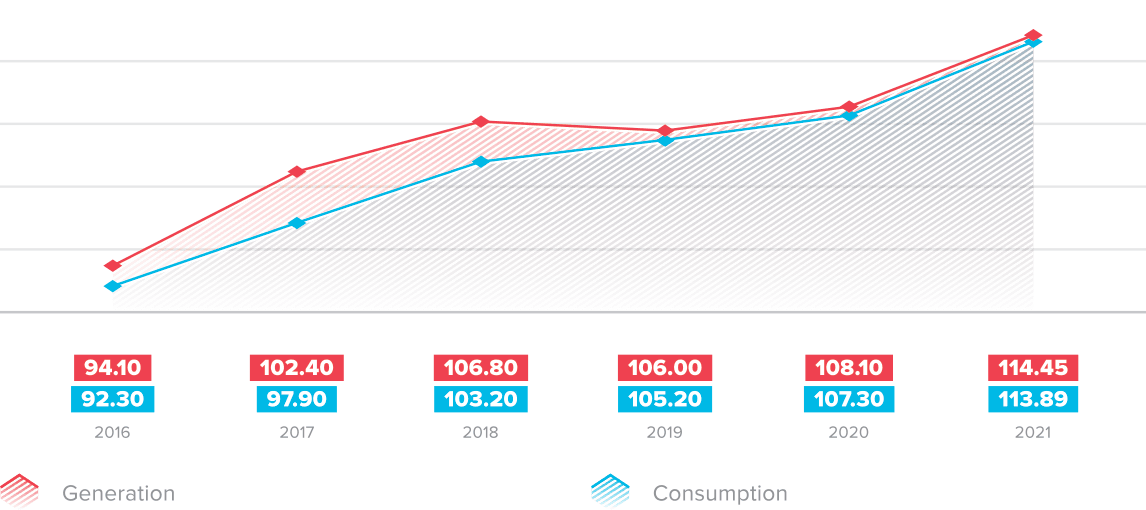
During the reporting period, the balance electricity flow from/to Russia was 461.7 million kWh (123.1 million kWh in 2020) including 1,326.6 million kWh (1,117.5 million kWh in 2020) of electricity export to Russia, which is 209.1 million kWh higher than in 2020 and 1,788.3 million kWh of electricity import from Russia, which is 547.7 million kWh higher than in 2020. The export and import are given taking into account power control services provided by the Russian counterpart.
Electricity balance flow on the border with Russia

The balance flow from/to Central Asia amounted to 1,019.3 million kWh including 1,324.5 million kWh of electricity export to Central Asia:
- 637.7 million kWh to Uzbekistan (400.3 million kWh from Ekibastuz GRES-1 LLP, 45.6 million kWh from Topar GRES LLP, and 191.8 million kWh from EGRES-2 JSC);
- 686.8 million kWh to Kyrgyzstan (680.3 million kWh as interchange from Ekibastuz GRES-1 LLP, 0.7 million kWh from Topar GRES LLP, 5.8 million kWh from KEGOC JSC to NES of Kyrgyzstan JSC).
Mining Data
Centres
One of the reasons for the sharp increase in electricity consumption in Kazakhstan in 2021 is the mass deployment of mining data centres.
According to the System Operator, the consumption of digital miners in Kazakhstan is more than 1,000 MW, excluding the shadow mining consumption.
In order to preserve the energy supply to the households, the Ministry of Energy of Kazakhstan has adopted a number of amendments to the regulatory documentation concerning the limitation of energy supply to digital miners.
The amendments give the System Operator the right to limit or reduce the scheduled supply of electricity to digital miners when planning and implementing daily schedule of electricity generation and consumption, if there is a shortage of electricity or generation capacity units or an emergency situation. The amendments also penalise power transmission, power generation, and power supplying organisations for failure to follow the instructions of the System Operator to limit the power supply to the digital mining consumers through penalty coefficients at the capacity market.
These coefficients also apply to power generating organisations for the sale of electricity to so-called “grey” miners. At the same time, if the electricity was found to be sold to “grey” miners in the past months, there is an arrangement to the return of income received by the energy supplying organisation through the electricity market for all the months when electricity was supplied to digital miners and not duly reported to the authorized information security body.
Non-compliance with the instructions of the System Operator within 7-8 days will nullify the income of an energy generating organisation in the capacity market and increase financial obligations of an energy supplying organisation in the capacity market by a factor of 28.
In accordance with the above-mentioned regulatory requirements and the minutes of the meeting that was held to consider the import of electricity and was chaired by the Deputy Minister of Energy of Kazakhstan on 01 October 2021, the System Operator shall limit the consumption of electricity by digital mining consumers in the event of a deficit of electricity and capacity and/or to prevent emergency situations.
The amount of digital mining electricity consumption limitations in 2021 was
- 83.259 million kWh in October
- 201.642 million kWh in November
- 200.036 million kWh in December.
Operations
Electricity
Transmission
Electricity transmission in KEGOC’s networks

The actual volume of electricity transmission services in the national electricity grid in 2021 was 54.65 billion kWh, which is 8.5 billion kWh or 18.4% higher than in 2020. The main reasons for the increase are:
- increase in the volume of electricity transmission for the wholesale market participants in Kazakhstan by 8.55 billion kWh, or 20.9%, compared to 2020;
- an increase of 0.09 billion kWh or 7.7% in electricity exports compared to 2020.
- In 2021, KEGOC provided for FGC UES PJSC contractual electricity transmission (transit) through KEGOC’s grids along Russia – Kazakhstan – Russia route to amount of 3,957.3 million kWh, which is 146.2 million kWh or 3.6% less than in 2020 (4,103.5 million kWh).
Technical
dispatching
Technical dispatching
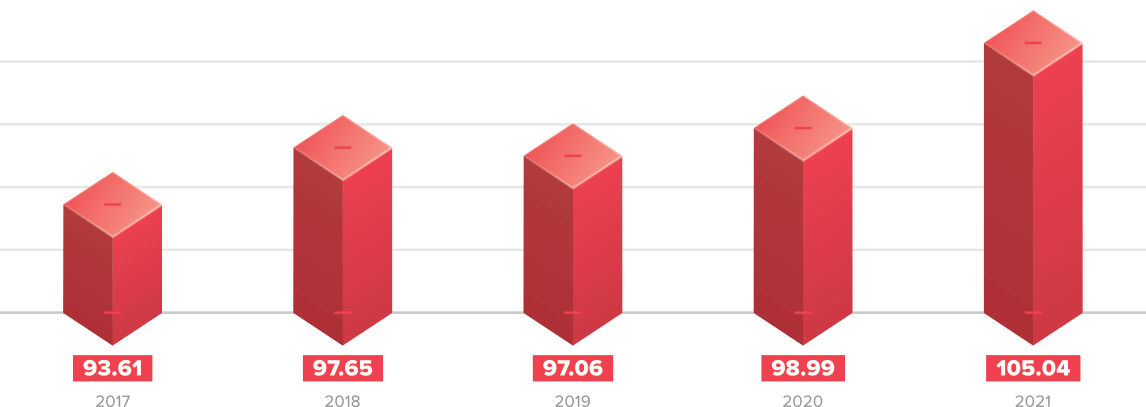
The actual volume of rendered technical dispatching of generation and consumption in the grid in 2021 was 105.04 billion kWh, which is 6.05 billion kWh or 6.11% higher than in 2020 due to the increase in electric power generation by power generating organizations of Kazakhstan.
Balancing Electricity
Production-Consumption
Electricity production and consumption balancing
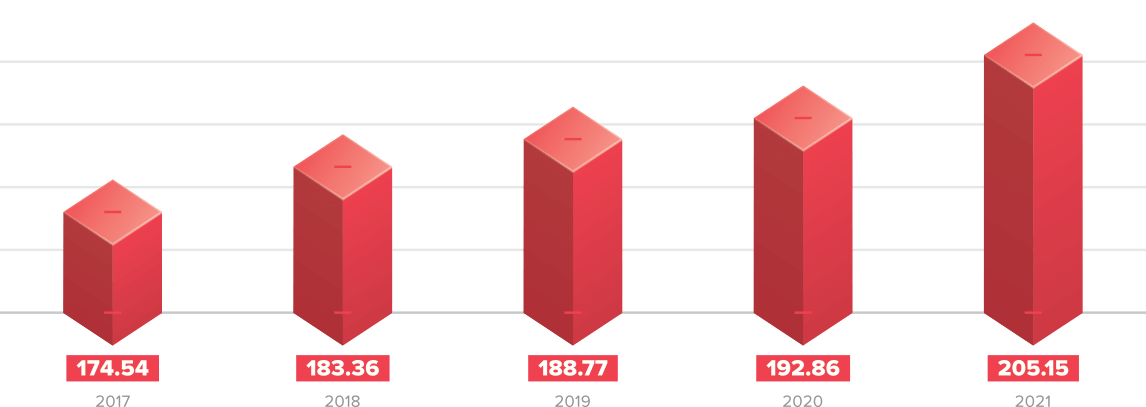
The actual volume of electricity production-consumption balancing services in 2021 was 205.15 billion kWh, which is 12.29 billion kWh or 6.37% higher than in 2020 due to the growth of electricity generation-consumption in the wholesale market of Kazakhstan.
KEGOC in the industry

Electricity
purchase and sale
transactions
In accordance with the Law of Kazakhstan on Electricity, KEGOC performs the function of the System Operator of the UPS of Kazakhstan for interaction with the power systems of neighbouring states to manage and ensure the stability of parallel operation.
In 2021, KEGOC purchased 1,267.7 million kWh of electricity to compensate for the hourly unscheduled deviations of the interstate electricity at the border of UPS of Kazakhstan and UES of the Russia the amount of KZT 22,157.8 million (17.48 KZT/kWh).
KEGOC sold 1,267.7 million kWh of electricity to compensate for the hourly unscheduled deviations of the actual interstate balance of power at the border of UPS of Kazakhstan and UPS of Russia in the amount of KZT 7,067.8 million (5.58 KZT/kWh).
Renewable
Energy Sources (RES)
development
Today, the RES is a fast-growing sector in Kazakhstan’s electricity production. It increases every year thanks to RES development programmes in Kazakhstan.
At the end of 2021, 134 RES facilities with a total installed capacity of 2,010 MW were in operation in Kazakhstan:
- 40 wind farms, 684 MW;
- 49 solar power plants, 1,038 MW;
- 40 hydropower facilities, 280 MW;
- 5 biomass power plants, 8 MW.
In 2021, 19 facilities with a total capacity of 393 MW were commissioned.
Information on RES electricity production in 2021
| Parameters | Units of measure | 2021 |
| Installed capacity including: | MW | 2,010.32 |
| wind power plants | MW | 683.95 |
| small hydropower plants | MW | 280.98 |
| solar power plants | MW | 1,037.61 |
| bio power plants | MW | 7.82 |
| Electricity generation including: | million kWh | 4,220.29 |
| wind power plants | million kWh | 1,776.41 |
| small hydropower plants | million kWh | 799.74 |
| solar power plants | млн кВт·ч | 1,641.09 |
| bio power plants | million kWh | 3.04 |
| RES-generated electricity in total electricity production | % | 3.69 |
| The increase in electricity generation by renewable energy facilities in 2021 compared to 2020 is 30% | ||
Network Reliability
The electricity sector is very important for Kazakhstan’s key energy intensive industries, such as metallurgy, oil and gas extraction. The competitiveness of Kazakhstan’s industry and the quality of life of the population largely depend on reliable and high-quality energy supply to consumers.
In 2021, 309 emergency outages occurred in KEGOC power grids (25% more than in 2020): in 129 cases the stable network operation was preserved by successful autoreclosing action, and in 180 cases the autreclosing was unsuccessful.
In 2021, the Company recorded and investigated 74 process failures, of which 2 emergencies, 4 failures class 1 and 68 failures class 2, which overall 54% higher than in 2020.
Technical disturbances by classes

In 2021, 48 technological failures occurred on power transmission lines including 14 with damage to the elements of the overhead lines.
Last year there were 26 technological failures at substations including 7 with damage to the primary equipment.
International best practice applies the following performance indicators to assess network reliability:
SAIDI
(System Average Interruption Duration Index) describes the average duration per system outage per year in minutes.

SAIFI
(System Average Interruption Frequency Index) describes the average frequency of power outages for consumers.
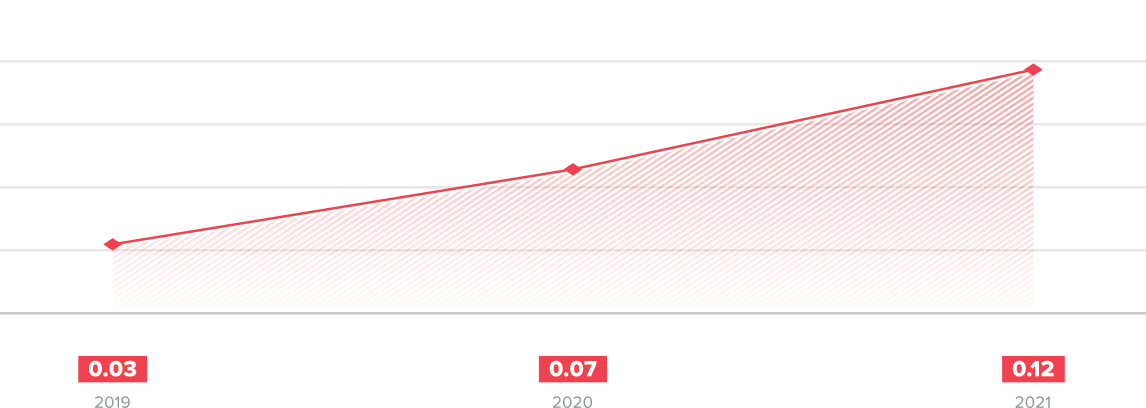
The growth in the number of emergency shutdowns and technological failures is due to the adverse weather conditions of 2021 and cannot be controlled by the Company.
41 technological failures (55% of the total) were caused by natural phenomena.
Emergency shutdowns of generating equipment significantly reduce the reliability of the UPS of Kazakhstan and lead to overloading in the sections controlled by the System Operator and occurrence of emergencies in the unified power system of Kazakhstan.
In 2021, for example, TPP boilers were stopped 1,073 times for 63,062 hours (1,104 times for 61,811 hours in 2020), which is 31 stops less and 1,251 hours more than in 2020.
Turbines in 2021 had 276 emergency stops for 44,366 hours (262 emergency stops for 27,191 hours in 2020), which is 14 stops and 17,175 hours more than in the previous year.
Power units in 2021 had 106 emergency stops for 6,486 hours (80 emergency stops for 4,389 hours in 2020) or 26 stops and 2,097 hours higher than in 2020.
Investments
KEGOC continues to successfully implement large-scale strategic projects.
2021 in Kazakhstan, like the rest of the world, was marked by the Covid-19 pandemic and the work in quarantine conditions.
However, the Company’s employees did their best to meet the planned level of investment. Despite the quarantine restrictions, the Company managed to meet the 2021 investment programme targets: the actual investments amounted to KZT 44.221 billion (excluding VAT), or 93% of the plan or KZT 47.723 billion (excluding VAT).
Status of work
on ongoing
projects:
Rehabilitation of 220-500 kV overhead lines in Aktyubinskiye MES, Zapadnye MES, and Sarbaiskiye MES branches of KEGOC. Stage I
Since the start of the project, construction and installation work has been carried out on 20 of the 24 overhead lines. The work has been completed on 12 overhead lines, of which 10 have been commissioned and an acceptance commission is working on the other two. Work is still in progress on the remaining 8 overhead lines. In total, since the beginning of the project, 1,306.7 km of 2,029 km of lines have been rehabilitated, including 456.7 km of overhead lines in 2021: 161.5 km of 500 kV and 295.2 km of 220 kV overhead lines.
Capital expenditure in 2021
Actual KZT 14.1 billion, vs planned KZT 12.3 billion.
West Kazakhstan Electricity Transmission Reinforcement Project
In 2021, construction and installation works were started at all five 220 kV lines: Uralskaya – Pravoberezhnaya, Pravoberezhnaya – Inder, Inder – Karabatan, Karabatan – Kulsary, and Kulsary – Tengiz.
In 2021, 1,227 out of 4,182 transmission towers were installed, which is 30% of the total number of towers. equipment worth KZT 2.4 billion was supplied. Equipment for rehabilitation of 220 kV Uralskaya, Pravoberezhnaya, Inder, Kulsary, Tengiz substations and construction of 220 kV Karabatan substation was supplied in 2021.
Capital expenditure in 2021
Actual KZT 4.1 billion, vs planned KZT 3.2 billion.
Turkestan External Power Supply Reinforcement Project
The detail design for rehabilitation of 220 kV overhead lines: L-2439 GNPS-Kentau, L-2309 GNPS-Shymkent, and construction of 220 kV Ortalyk substation were completed in 2021, permits for construction and installation works have been received.
Construction of the cross-connection lines for connection of 220 kV Ortalyk substation have been completed, the earthwork for the access road and installation of foundations for the open switchgear gantry posts have been completed.
220 kV autotransformers, 110, 220 kV current and voltage transformers, 110, 220 kV disconnectors, 110, 220 kV bus supports, 10, 110, 220 kV surge arresters, protective relay equipment (cabinets) and materials (reinforced concrete products, metal) were supplied.
Capital expenditure in 2021
Actual KZT 4.4 billion vs planned KZT 4.3 billion.
Future projects
being developed
in 2021:
North-South HVDC Electricity Transmission Construction Project.
В In 2021 a pre-feasibility study for the project was completed by the contractor as the first part of a two-stage feasibility study. The results of the pre-feasibility study were preliminarily approved by the Scientific and Technical Council and the Management Board of KEGOC. The results of the feasibility study are being coordinated with Samruk-Kazyna to move the project to the next stage in view of the approval of the Energy Balance until 2035.
South Kazakhstan Electricity Transmission Reinforcement Project. Construction of power grid facilities.
Reinforcement of the backbone 500-220 kV power network to enhance power supply reliability for consumers in Zhambyl, Kyzylorda, Turkestan and Almaty oblasts.
Based on the results of an open tender, a contract for a feasibility study was concluded with KazSelEnergoProyekt Institute LLP. A feasibility study is under development and will determine the parameters and timing of the project.
West Kazakhstan Electricity Transmission Interconnection Project.
Engagement of Zone West power system in the overall energy balance of the country’s energy system and generally improving the reliability of power supply to consumers in Zone West through construction of backbone power lines connecting it with the main part of the UPS of Kazakhstan across the inland territory of Kazakhstan.
In order to make an optimal decision on interconnection of Zone West with the UPS of Kazakhstan (length of overhead transmission line, route, AC or DC), KEGOC, following an open tender, concluded a contract for a pre-feasibility study of the project with AUPET NJSC. The pre-feasibility study is under development.
Ekibastuz Industrial Zone External Power Supply Project. Construction of Power Grid Facilities.
Earlier, the akimat administration of the Pavlodar oblast initiated the construction of the Ekibastuz Industrial Zone (with an electricity load of over 500 MW). This project shall provide external power supply to the Industrial Zone.
The project involves construction of a new 500 kV substation and 500 kV interconnection with 1,150 kV Ekibastuz substation. The project will provide for power supply to the Industrial Zone of Ekibastuz from 220 kV buses of the new 500 kV substation.
A contract has been concluded between KEGOC and KazNIPIITES Energy for the development of the feasibility study of the project. The feasibility study is under development.
The current capital investment for local and pilot projects amounted to KZT 2,082.637 million vs a plan of KZT 2,903.923 million. Segmentation of internal networks, development of a feasibility study of modernisation of SCADA/EMS system and introduction of automated information and management system of the enterprise (extended business processes) are in progress. Modernisation of automatic frequency and power cross-flow regulation system and WACS control system based on WAMS synchrophasor measurements have been completed.
The actual capital expenditure to maintain the operations amounted to KZT 19,518.043 million (excluding VAT) vs the plan of KZT 22,694.422 million (excluding VAT).
KEGOC will continue to implement projects in 2022:
- Rehabilitation of 220-500 kV overhead lines in Aktyubinskiye MES, Zapadnye MES, and Sarbaiskiye MES branches of KEGOC. Stage I;
- West Kazakhstan Electricity Transmission Reinforcement Project;
- Turkestan External Power Supply Reinforcement Project.
Tariff
Policy
From 1 January 2021 until the approval of the new tariffs KEGOC had been providing the regulated services as follows:
- electricity transmission at 2.448 KZT/kWh;
- technical dispatching of generation and consumption of electricity in the grid at 0.264 KZT/kWh;
- electricity production-consumption balancing at 0.086 KZT/kWh.
Order No.79-OD of CRNM dated 16 August 2021 approved tariffs and tariff estimates for regulated services of KEGOC for 2021–2026 effective from 1 October 2021 to 30 September 2026 as follows:
| KZT/kWh | 01.10.2021–30.09.2022 | 01.10.2022–30.09.2023 | 01.10.2023–30.09.2024 | 01.10.2024–30.09.2025 | 01.10.2025–30.09.2026 |
| Electricity transmission in the NPG | 2.797 | 2.848 | 3.004 | 3.106 | 3.134 |
| Technical dispatching of generation and consumption of electricity in the grid | 0.306 | 0.314 | 0.333 | 0.348 | 0.355 |
| Balancing of electricity production-consumption | 0.098 | 0.102 | 0.105 | 0.108 | 0.110 |
Analysis of
Financial and Economic
Performance
Plan vs Actual Analysis
| KZT million | 2021 plan | 2021 actual | Deviation | Rationale |
| Rationale | 384,864.0 | 199,424.1 | -48.2% | |
|
377,343.3 | 186,443.1 | -50.6% | The decrease was mainly due to the alienation (donation) of FSC RES LLP in December 2021 into state ownership, as a result of which revenue from the sale of purchased electricity generated by renewable energy sources and the provision of services of electric capacity readiness to bear the load was reclassified to income from discontinued operations. In addition, the provision of services at tariffs without an investment component had a negative impact, which was offset by an increase in the amount of provided services. |
| Consolidated costs | 340,015.5 | 152,651.8 | -55.1% | |
|
317,100.5 | 120,682.9 | -61.9% | The decrease is mainly due to the reclassification of costs for the purchase of renewable electricity and the purchase of electricity capacity availability services as a result of discontinued operations. In addition, property tax costs have decreased compared to the planned ones as a result of a lower property tax base due to changes in the fixed asset classifier. Also, the costs decreased for: electricity purchased to compensate for non-contractual consumption as a result of unscheduled power flows to Central Asia; transmission services (during repairs) and other operating expenses as a result of ongoing cost optimisation measures. At the same time, expenses increased for purchase of electricity to compensate for unscheduled hourly deviations in the actual interstate electricity flow as a result of higher actual purchase amount; for compensation of technical losses as a result of increase in electricity purchase price, for repair of power grid assets mainly as a result of emergency recovery works in the South Kazakhstan oblast. |
|
9,963.5 | 8,539.8 | -14.3% | The decrease was mainly due to the alienation of FSC RES LLP. |
|
422.7 | 381.2 | -9.8% | The decrease is mainly the result of cost reduction |
| Impairment loss/gain | -7,944.0 | Property, plant and equipment under “Structures” class has been revaluated out as at 01 December 2021. | ||
| Operating profit | 49,856.5 | 48,895.2 | -1.9% |
Analysis of Actual Income and Expenditure for 2021 vs 2020
| KZT million | 2020* | 2021 | Deviation | Rationale |
| Consolidated revenues | 185,852.9 | 199,424.1 | 7.3% | |
| Operating income | 179,097.6 | 186,443.1 | 4.1% | The increase is due to an increase in the amount of electricity transmission in the national power grid, as well as an increase in electricity sales to compensate for hourly deviations in the inter-state power flow balance. |
| Consolidated costs | 127,253.8 | 152,651.8 | 20.0% | |
| Cost of services | 101,920.9 | 120,682.9 | 18.4% | The increase is mainly due to higher expenses for the purchase of electricity to compensate for the hourly unscheduled deviations of the actual interstate balance of power flows and for technical losses of electricity, to an increase in costs of depreciation, repair and maintenance of electric grid assets. At the same time, there was a decrease in property tax expenses as a result of a reduction in the property tax base due to changes in the fixed asset classifier. |
| General and administrative costs | 7,817.1 | 8,539.8 | 9.3% | The increase is mainly attributable to higher depreciation costs as well as increased costs for the purchase of information security services. |
| Sales expense | 364.1 | 381.2 | 4.7% | Labour costs have increased due to salary indexation |
| Impairment loss/gain | -19.2 | -7,944.0 | Property, plant and equipment under “Structures” class has been revaluated out as at 01 December 2021. | |
| Operating profit | 68,976.2 | 48,895.2 | -29.1% |
* – Recalculated considering alienation of FSC RES LLP
The above factors influenced the operating profit and financial performance in 2021.
Financial and economic performance

Ratio
Analysis
Key indicators
| Indicator | 2019, actual | 2020, actual | 2021, actual |
| Strategic KPIs, level 1 | |||
| ROACE, % | 7.47 | 9.48 | 7.70 |
| EBITDA*, KZT million | 80,221.7 | 103,391.9 | 93,865 |
| Covenants laid down in loan agreements | |||
| Current liquidity ratio, not less than 1 | 2.19 | 1.69 | 1.61 |
| Covenants established by Samruk-Kazyna JSC | |||
| Debt/EBITDA, not exceeding 3.80 | 1.70 | 1.49 | 1.82 |
| Debt/Equity, not more than 1.40 | 0.31 | 0.32 | 0.23 |
* – Recalculated considering alienation of FSC RES LLP
During 2021, the standards for financial stability indicators and covenants have not been breached.
Economic value
generated and
distributed
Economic value distribution
| KZT million | 2019 | 2020 | 2021 |
| Total capitalisation | 632,163.54 | 663,590.50 | 908,336.27 |
|
481,838.02 | 502,556.47 | 737,136.82 |
|
150 325,52 | 161 034,03 | 171 199,45 |
| Funds received from the state | 0 | 0 | 0 |
| Economic value created * | 160,158.80 | 185,852.94 | 199,424.10 |
|
154,629.42 | 179,097.56 | 179,097.56 |
|
3,581.81 | 5,480.24 | 5,368.22 |
|
1,947.57 | 1,275.13 | 7,612.74 |
| Allocated economic value *: | 157,587.49 | 170,101.47 | 201,789.23 |
|
20,167.09 | 21,101.73 | 23,672.49 |
|
17,932.84 | 21,334.15 | 14,047.26 |
|
40,842.53 | 43,952.81 | 53,200.01 |
|
|||
|
78,260.29 | 77,761.28 | 99,492.06 |
|
384.74 | 5,951.50 | 11,377.43 |
|
6,535.83 | 4,967.04 | 13,471.47 |
| Economic value for distribution | 9,107.14 | 20,718.50 | 11,106.33 |
* – recalculated considering alienation of FSC RES LLP
Balance
Sheet Analysis
| Indicator, KZT million | 2018 | 2019 | 2020 | 2021 | 2021–2020 |
| Non-current assets | 698,081.7 | 659,175.9 | 695,192.5 | 1,019,820.4 | 46.70% |
| Current assets | 57,769.0 | 97,111.0 | 116,820.1 | 73,396.9 | -37.17% |
| Total assets | 73,396.9 | 756,987.7 | 812,012.6 | 1,093,217.3 | 34.63% |
| Capital | 472,693.8 | 481,838.0 | 502,556.5 | 737,136.8 | 46.68% |
| Non-current liabilities | 236,958.6 | 230,808.2 | 239,766.9 | 310,396.6 | 29.46% |
| Short-term liabilities | 46,198.3 | 44,341.5 | 69,689.2 | 45,683.9 | -34.45% |
| Total liabilities | 283,156.9 | 275,149.7 | 309,456.1 | 356,080.5 | 15.07% |
| Total equity and liabilities | 755,850.7 | 756,987.7 | 812,012.6 | 1,093,217.3 | 34.63% |
Risk Management
and Internal
Control
The risk
management
process

KEGOC’s most important and relevant risks
- Risk of work-related accidents
- Foreign exchange risk
- Counterparty bank credit risk
- Coronavirus risk
- Non-payment by counterparties for system services provided
- Reduction by CRNM of approved cap tariffs, including introduction of a compensatory tariff
- Failure of operational assets
- Risk of capacity shortages in Kazakhstan’s UPS
